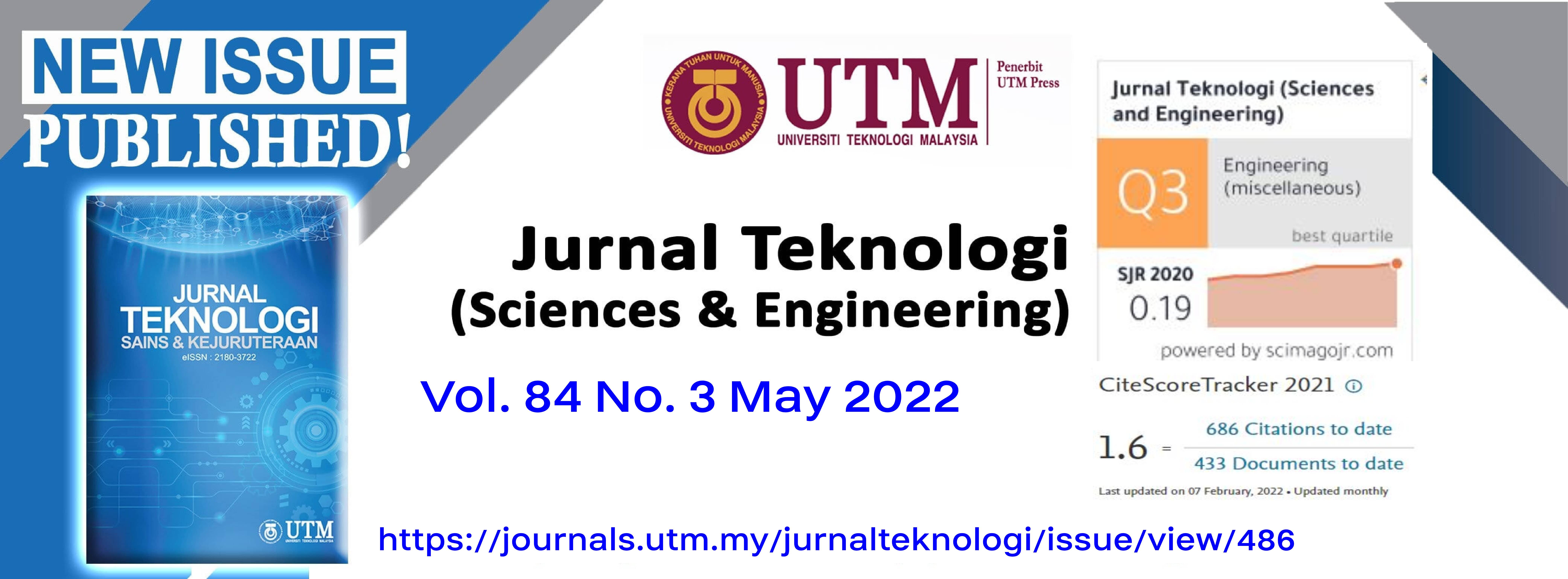MODELLING OF CAPACITIVE POWER TRANSFER SYSTEM BASED ON CLASS-E LCCL TOPOLOGY
DOI:
https://doi.org/10.11113/jurnalteknologi.v84.17250Keywords:
Capacitive power transfer, Class-E inverter, Duty cycle variation, Gap distance variation, Impedance matching, Load variation, Zero-voltage switching (ZVS)Abstract
Nowadays, capacitive power transfer (CPT) is becoming increasingly popular technology in the wireless charging field due to its better mobility and higher durability. This paper proposed a CPT system by using Class-E inverter. This topology is selected due to its ability to achieve 100% efficiency theoretically. L-match impedance matching circuits are applied at both transmitter and receiver part to allow the load impedance to match with the source impedance to maximize the power transfer. The proposed CPT system is designed and simulated by using Simulink in MATLAB software. Its output performances are analyzed. Besides, the designed CPT system is used to investigate the factors that affect its output performance by varying the load, duty cycle and gap distance between coupling plates. From this work, the proposed CPT system produced up to 97.35% efficiency and output power of 10W.
References
C. H. Lee, G. Jung, K. Al Hosani, B. Song, D. K. Seo, and D. Cho. 2020. Wireless Power Transfer System for an Autonomous Electric Vehicle. 2020 IEEE Wireless Power Transfer Conference, WPTC 2020. 467-470. Doi: 10.1109/WPTC48563.2020.9295631.
Z. Zhang, H. Pang, A. Georgiadis, and C. Cecati. 2019. Wireless Power Transfer - An Overview. IEEE Trans. Ind. Electron. 66(2): 1044-1058. Doi: 10.1109/TIE.2018.2835378.
J. Lopez-Lopez, C. Salto, P. Zumel, C. Fernandez, A. Rodriguez-Lorente, and E. Olias. 2018. High Efficiency Capacitive Power Transfer Converter. Conf. Proc. - IEEE Appl. Power Electron. Conf. Expo. - APEC. 2018: 3149-3153. Doi: 10.1109/APEC.2018.8341551.
F. C. Domingos, S. Vital, D. C. De Freitas, and P. Mousavi. 2018. Capacitive Power Transfer based on Compensation Circuit for Class E Resonant Full-Wave Rectifier. 2018 IEEE Wirel. Power Transf. Conf. 1-4.
Y. Zhao, B. Mahoney, and J. R. Smith. 2016. Analysis of a Near Field Communication Wireless Power System. 2016 IEEE Wirel. Power Transf. Conf. WPTC 2016. 2-5. Doi: 10.1109/WPT.2016.7498827.
I. Ramos, K. Afridi, J. A. Estrada, and Z. Popović. 2016. Near-field Capacitive Wireless Power Transfer Array with External Field Cancellation. 2016 IEEE Wirel. Power Transf. Conf. WPTC 2016. 4-7. Doi: 10.1109/WPT.2016.7498829.
C. Liu, Y. X. Guo, H. Sun, and S. Xiao. 2014. Design and Safety Considerations of an implantable Rectenna for Far-field Wireless Power Transfer. IEEE Trans. Antennas Propag. 62(11): 5798-5806. Doi: 10.1109/TAP.2014.2352363.
P. S. Yedavalli, T. Riihonen, X. Wang, and J. M. Rabaey. 2017 Far-Field RF Wireless Power Transfer with Blind Adaptive Beamforming for Internet of Things Devices. IEEE Access. 5: 1743-1752. Doi: 10.1109/ACCESS.2017.2666299.
Y. Yusop et al. 2016. A Study of Capacitive Power Transfer Using Class-E Resonant Inverter. Asian J. Sci. Res. 9(5): 258-265. Doi: 10.3923/ajsr.2016.258.265.
V. T. Nguyen, S. D. Yu, S. W. Yim, and K. Park. 2017. Optimizing Compensation Topologies for Inductive Power Transfer at Different Mutual Inductances. 2017 IEEE PELS Work. Emerg. Technol. Wirel. Power Transf. WoW 2017. 1: 153-156. Doi: 10.1109/WoW.2017.7959384.
“3rd International Conference on Properties and Applications of Dielectric Materials,” IEEE Trans. Electr. Insul., vol. 27, no. 2, pp. 405–674, 1992.
A. Aldaoud, J. Redoute, K. Ganesan, and D. J. Garrett. 2018 Near Field Wireless Power Transfer to Stent-based Biomedical Implants. 1-8. Doi: 10.1109/JERM.2018.2833386.
Z. Mustapa, S. Saat, and Y. Yusof. 2019. A New Design of Capacitive Power Transfer based on Hybrid Approach for Biomedical Implantable Device. 9(4): 2336-2345. Doi: 10.11591/ijece.v9i4.pp2336-2345.
B. Jalali and A. Mahjoubfar. 2015. Tailoring Wideband Signals with a Photonic Hardware Accelerator. Proc. IEEE. 103: 1071-1086. Doi: 10.1109/JPROC.2015.2418538.
F. Lu, S. Member, H. Zhang, S. Member, H. Hofmann, and S. Member. 2016. A CLLC-Compensated High Power and Large Air- Gap Capacitive Power Transfer System for Electric Vehicle Charging Applications. 1721-1725.
B. Luo, T. Long, L. Guo, R. Dai, R. Mai, and Z. He. 2020. “and Design of Inductive and Capacitive Hybrid Wireless Power Transfer System for Railway Application. IEEE Trans. Ind. Appl. 56(3): 3034-3042. Doi: 10.1109/TIA.2020.2979110.
B. Regensburger, A. Kumar, S. Sinha, and K. Afridi. 2018. High-Performance 13.56-MHz Large Air-gap Capacitive Wireless Power Transfer System for Electric Vehicle Charging. 2018 IEEE 19th Work Control Model. Power Electron. COMPEL 2018. 1-4. Doi: 10.1109/COMPEL.2018.8460153.
H. Zhang, C. Zhu, S. Zheng, Y. Mei, and F. Lu. 2019. High Power Capacitive Power Transfer for Electric Aircraft Charging Application. Proc. IEEE Natl. Aerosp. Electron. Conf. NAECON. 2019-July(c): 36-40. Doi: 10.1109/NAECON46414.2019.9057957.
R. H. Tarek M. Mostafa, Aam Muharam. 2017. Wireless Battery Charging System for Drones via Capacitive Power Transfer.
Y. Yusop, S. Saat, Z. Ghani, H. Husin, and S. K. Nguang. 2019. Cascaded Boost-Class-E for Rotary Capacitive Power Transfer System. 3742-3748. Doi: 10.1049/joe.2018.8016.
Downloads
Published
Issue
Section
License
Copyright of articles that appear in Jurnal Teknologi belongs exclusively to Penerbit Universiti Teknologi Malaysia (Penerbit UTM Press). This copyright covers the rights to reproduce the article, including reprints, electronic reproductions, or any other reproductions of similar nature.
















